Quintana Roo’s New PR3
The old farmer gets the whiff of approaching weather before others can smell it. This old triathlete’s nose twitches when tri bike launches are approaching. They’re coming. I can smell them.
The first is Quintana Roo’s PRthree, announced today.
Bikes, and components, when announced, typically fall into two categories: Halo technologies and designs that appeal to the bourgeoisie and are priced out of the range of the proletariat; versus technologies and features trickling down since their pricey intros a few years before.
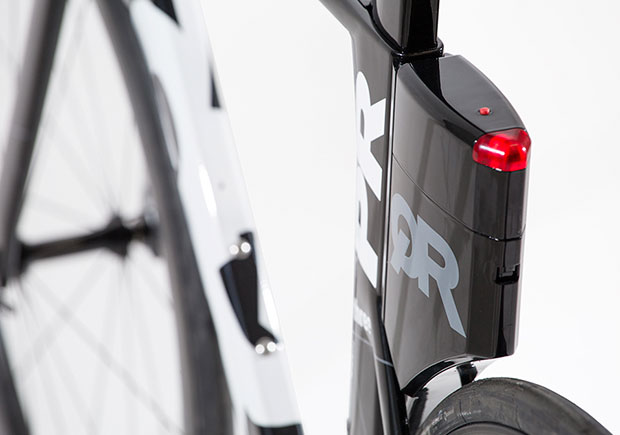
The PRthree is trickle-down; a bike for the proletariat. This bike shares the basic frame design of the PRsix, which was first shown in March, 2014 and remains QR’s flagship superbike. That bike, two years ago, had one spec and the cost then was $8,500. Predictably. It was a halo bike.
A year and a month ago the PRfive arrived, the first trickle-down version of the PRsix. Its main difference was a more standard fork and front end, and on it was a standard (not integrated) stem. You might say that Felt and Quintana Roo had the same idea at about the same time: Felt’s IA downstreamed to the IAx, turning a superbike mortal, and at a mortal price. The PRfive started at $3,700, still a chunk but a mortal bike for mortal earners.
These QR bikes were, along with Cervelo, the best selling bikes during the Slowtwitch Road Shows earlier this year. I remember 8 of these PR series bikes getting sold at the very first Road Show, at Inside Out Sports in North Carolina, and it was clear there was an end-user appeal to these bikes I hadn’t fully realized.
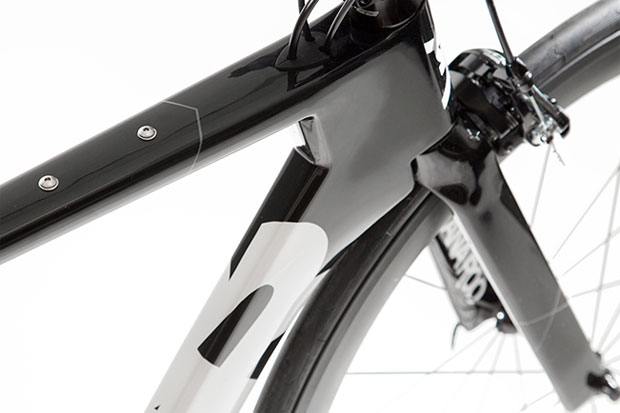
The PRthree will further pressure the market because of its $2,500 price in the less-dear of its two price configurations. What’s most compelling about this bike is that it hits the entry-level square in the pricing sweet spot, and it includes the QBox, which is QR’s version of the ingenious Speed Box Bontrager made for the Trek Speed Concept. The QBox didn’t make it onto the PRfive, but there it is on a $2,500 bike!
Aerodynamics and Weight
Quintana Roo’s Shift technology is a method by which an asymmetrical down tube shifts the air away from the drive side of the bike to the cleaner side. Here’s the problem: there is no evidence I can find that says the drive side is the dirty side. Nevertheless, the bike works reasonably well aerodynamically. Why?
I don’t know, but I think it’s because the dirty side (the left side) is cleaned up by a massive chain stay with a lot of surface area. The bike is not THE most aerodynamic, but it’s certainly in the hunt. It’s enough in the hunt. It works very well between the 10s, that is, in a sweep between 10° of yaw on each side and as we’ve seen that’s where we all spend almost all our time while riding, except for on the windiest of days.
Below is the wind tunnel data QR released on its PRthree, I cannot vouch for the protocol. One thing: That chart also does not contain Argon18's new bikes, the E-117 and E-119, and realize Felt's go-to tri bike is the IA not the DA.
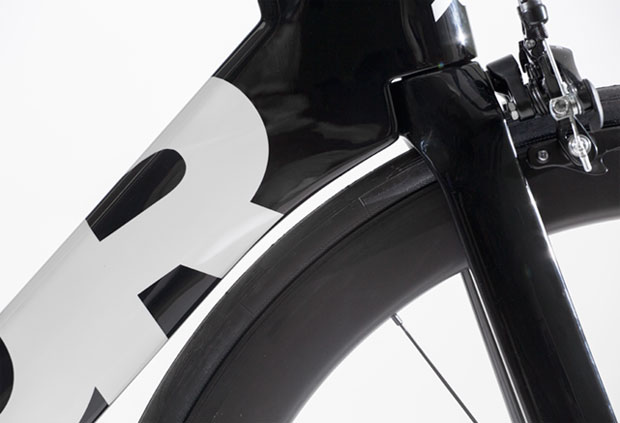
QR also does something not all companies do, and you wouldn’t see it unless you’re looking. It’s easier to design a bike with the angles in the main tube joints the same, with the top and head tubes scaled smaller or larger throughout the size run. QR retains as a design imperative the distance from the down tube from the trailing edge of the rear wheel, and all its sizes have that same wheel-to-down-tube relationship. This means, on paper, that the aero performance of these bikes are retained as the bike scales in size.
Because these QR framesets are not big surface area bikes – like the Shiv and the IA – they can be made lighter. QR takes frameset weights into account when making its tri bike and there is a physics-based narrative “proving” that weight is immaterial to tri bikes, but try telling that to those who race bikes and triathlons for a living.
Ease of Use
From the beginning, in the design of the PRsix, QR had the sense that a segment of the triathlon population wanted simplicity, ease of bike travel, ease of adjustment and maintenance. The very first thing QR’s folks told me about the PRsix is, “You can work on the entire bike with just 2 sizes of Allen wrench.”
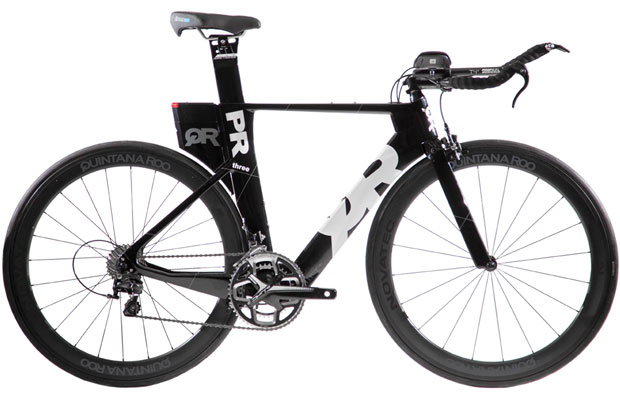
Count me one who is thankful. I’ve been on the side of the road, or in a remote location away from my tools, needing to fix, tighten or adjust something only to – Arggh! – find out that it’s a 1.5mm Allen or a 25 Torx I need, and that I don’t have with me.
Spec
Alas, I can’t tell you much. The kit is built around Shimano 105. The Shimano 105-Mix is the $2,500 build, and the 105-Race Mix sells for $3,600. I haven’t seen this bike in person. Pics here do not show a 105 crank, rather it appears to be a 4-bolt FSA Gossamer Pro ABS, which is a fine crankset, but I don’t know yet where the 105 stops and the cross- or down-spec starts. When I know, you’ll know.
Fit
Slowtwitchers who read what we write about fit know that QR’s PR series bikes fit very much like the Speed Concept, Felt’s IA, and Cervelo’s tri bikes. There is the ubiquitous stack 540mm, reach 425mm bike that just about every company has now for people 6-feet tall, and the only thing that changes much is the name attached to that size. In Dimond it’s size-M, Trek it’s size-L, and depending on the numerical size attached by various companies it’s a 58, 56 or 54.
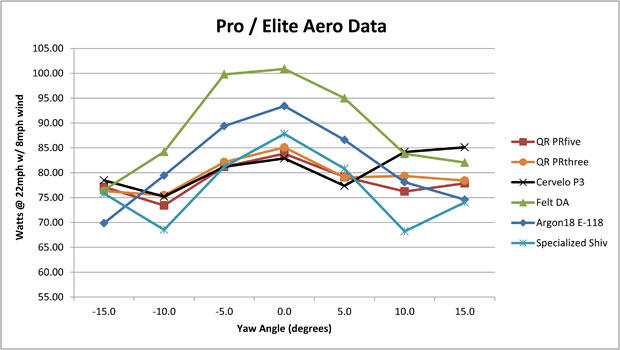
In QR’s case it’s a 54 and this is because QR has decided the size of the frame ought to mean something and the thing it means is stack. A size 54 has a stack of 54cm (540mm). But that’s a tall stack, more indicative of a frame for a person 6-feet tall more or less, so you’ll need to wrap your brain around the fact that if you want this bike you’ll get it in a size that sounds too small. Don’t worry about it. Just look at the stack and reach of this bike, realize it’s the same as that of a Felt or Cervelo in size-56, and there you go.
Look, I ride a Cannondale Supersix EVO in size-58. That’s my everyday road bike. I’m thinking about maybe a Specialized Tarmac, but if I get it, it’ll be size-56, because that’s the size that will fit me. This QR bike? Size-54m. That’s what fits. It’s just math, baby. It’s just dimensions. Tube lengths that conspire to perch that head tube top so far in front of the BB and so high above it. Math is your friend. Get the size that fits, not the size that sounds right.
UPDATE: This bike model is not made in the 58.5cm nor the 46cm size. It's made just from 48cm up through 56cm. If you need a 650c-wheel bike you must go to the PRfive, or one of QR's other models, or another bike. I'm glad QR didn't smoosh down a 46cm bike over 700c wheels – I'd rather they just not make that size altogether. If you are shorter than 5’5” you need to start to seriously consider this wheelsize, not just for the height of the bike you need, but for the length. For those who disagree with me, blah, blah, blah. I’ve heard it all. I intro’d the 650c into road and tri 30 years ago, I’ve had 30 years to consider where this wheel wins and where it loses. There just are few good arguments in favor of 700c for a 5’1” or 5’3 person looking for a tri bike. This isn’t to say that bike and wheel companies take full advantage of 650c, but that’s another story.
Conclusion
QR is going to be a force in these next uncertain years. The bike, run and tri industries and markets are all facing headwinds at the moment. This company, QR, wages asymetric warfare. You’re liable to see these guys at a Slowtwitch Road Show, or an Ironman expo, or a tri club meeting. While other, larger companies will retrench, pull in their spending and hunker down, this company is expanding, looking to take market share. In the insurance industry they call it “buying business.” The PRthree is predatorily priced. This bike is not just a bike, it’s a window into this company’s hungry and lean-forward business posture.


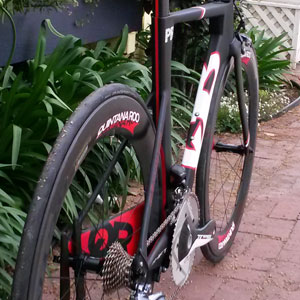
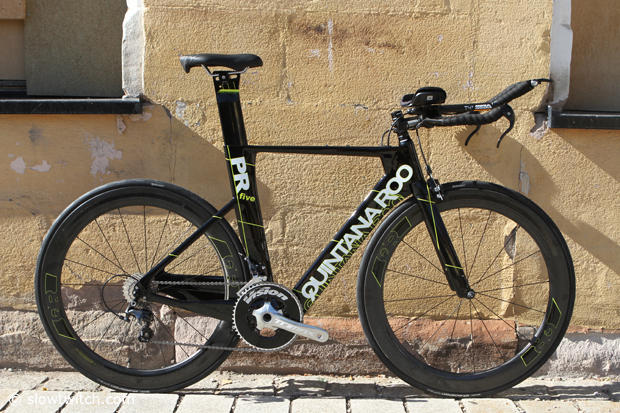
Start the discussion at slowtwitch.northend.network